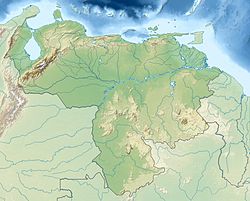Apón Formation
| Apón Formation | |
|---|---|
| Stratigraphic range: Early Cretaceous (Late Aptian) | |
| Type | Geological formation |
| Sub-units | Machiques Member |
| Underlies | Aguardiente Formation |
| Overlies | Río Negro Formation |
| Lithology | |
| Primary | Limestone, marl |
| Other | Calcareous and sandy shales |
| Location | |
| Coordinates | 10°57′30″N 71°38′50″W / 10.95833°N 71.64722°W |
| Approximate paleocoordinates | 7°42′N 41°06′W / 7.7°N 41.1°W |
| Region | La Guajira, Maracaibo Basin |
| Country | |
| Type section | |
| Named for | Apón River |
The Apón Formation is a geological formation in northwestern Venezuela (Maracaibo Basin) and northern Colombia (La Guajira),[1] whose thick-bedded limestone interbedded with subordinate amounts of dark gray calcareous shale and sandy shale strata date back to the Early Cretaceous (Late Aptian epoch).[2] Pterosaur remains of Ornithocheiridae indet. (= ?Anhangueridae indet.) are among the fossils that have been recovered from the formation.[3]
Fossil content
The following fossils, among others, have been found in the Apón Formation at Toas island: Spiroculina sp., Orbitolina concava, Gryphaeostrea, Amphidonte (Ceratostreon) boussingaulti, Ostrea sp., Amphitriscoelus waringi, Requienia sp., Parahoplites sp., Cheloniceras sp., Quinqueloculina sp., Triloculina sp.,[2] and Panopea (Myopsis) plicata in Río Negro.[4]
See also
References
- ^ García González et al., 2010
- ^ a b Apón Formation (Toas Island) at Fossilworks.org
- ^ Barrett et al., 2008, p.84
- ^ Apón Formation (Río Negro) at Fossilworks.org
Bibliography
- Geologic formations of Colombia
- Geologic formations of Venezuela
- Lower Cretaceous Series of South America
- Cretaceous Colombia
- Cretaceous Venezuela
- Limestone formations
- Marl formations
- Shallow marine deposits
- Aptian Stage
- Fossiliferous stratigraphic units of South America
- Paleontology in Venezuela
- Geography of La Guajira Department
- Geography of Zulia
- Maracaibo basin
- Colombia–Venezuela border

